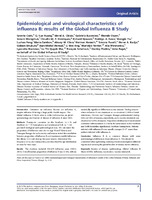Please use this identifier to cite or link to this item:
http://sgc.anlis.gob.ar/handle/123456789/1385| Title: | Epidemiological and virological characteristics of influenza B: results of the Global Influenza B Study | Authors: | Caini, Saverio Huang, Q Sue Ciblak, Meral A Kusznierz, Gabriela F. Owen, Rhonda Wangchuk, Sonam Henriques, Cláudio M P Njouom, Richard Fasce, Rodrigo A Yu, Hongjie Feng, Luzhao Zambon, Maria Clara, Alexey W Kosasih, Herman Puzelli, Simona Kadjo, Hervé A Emukule, Gideon O Heraud, Jean-Michel Ang, Li Wei Venter, Marietjie Mironenko, Alla Brammer, Lynnette Mai, Le Thi Quynh Schellevis, François Plotkin, Stanley Paget, John |
Keywords: | Estudio Global de Influenza B (GIBS);Carga de enfermedad;Epidemiología;Gripe Humana;Vacunación;vaccine mismatch | Issue Date: | Aug-2015 | Journal: | Influenza and other respiratory viruses | Abstract: | INTRODUCTION: Literature on influenza focuses on influenza A, despite influenza B having a large public health impact. The Global Influenza B Study aims to collect information on global epidemiology and burden of disease of influenza B since 2000. METHODS: Twenty-six countries in the Southern (n = 5) and Northern (n = 7) hemispheres and intertropical belt (n = 14) provided virological and epidemiological data. We calculated the proportion of influenza cases due to type B and Victoria and Yamagata lineages in each country and season; tested the correlation between proportion of influenza B and maximum weekly influenza-like illness (ILI) rate during the same season; determined the frequency of vaccine mismatches; and described the age distribution of cases by virus type. RESULTS: The database included 935 673 influenza cases (2000-2013). Overall median proportion of influenza B was 22·6%, with no statistically significant differences across seasons. During seasons where influenza B was dominant or co-circulated (>20% of total detections), Victoria and Yamagata lineages predominated during 64% and 36% of seasons, respectively, and a vaccine mismatch was observed in ≈25% of seasons. Proportion of influenza B was inversely correlated with maximum ILI rate in the same season in the Northern and (with borderline significance) Southern hemispheres. Patients infected with influenza B were usually younger (5-17 years) than patients infected with influenza A. CONCLUSION: Influenza B is a common disease with some epidemiological differences from influenza A. This should be considered when optimizing control/prevention strategies in different regions and reducing the global burden of disease due to influenza. |
URI: | http://sgc.anlis.gob.ar/handle/123456789/1385 | DOI: | 10.1111/irv.12319 |
| Appears in Collections: | Publicaciones INER |
Files in This Item:
| File | Description | Size | Format | |
|---|---|---|---|---|
| irv0009-0003.pdf | Artículo en inglés | 315.29 kB | Adobe PDF |  View/Open |
Page view(s)
172
checked on Dec 30, 2025
Download(s)
33
checked on Dec 30, 2025
Google ScholarTM
Check
Altmetric
Altmetric
Items in DSpace are protected by copyright, with all rights reserved, unless otherwise indicated.

